Rank #1 on all Search Engines
Find out the secrets, tips and tricks to ranking number 1 on Google.
Your ultimate website ranking guide.
Friday, October 9, 2020 (MDT)
Author: Emad Zaamout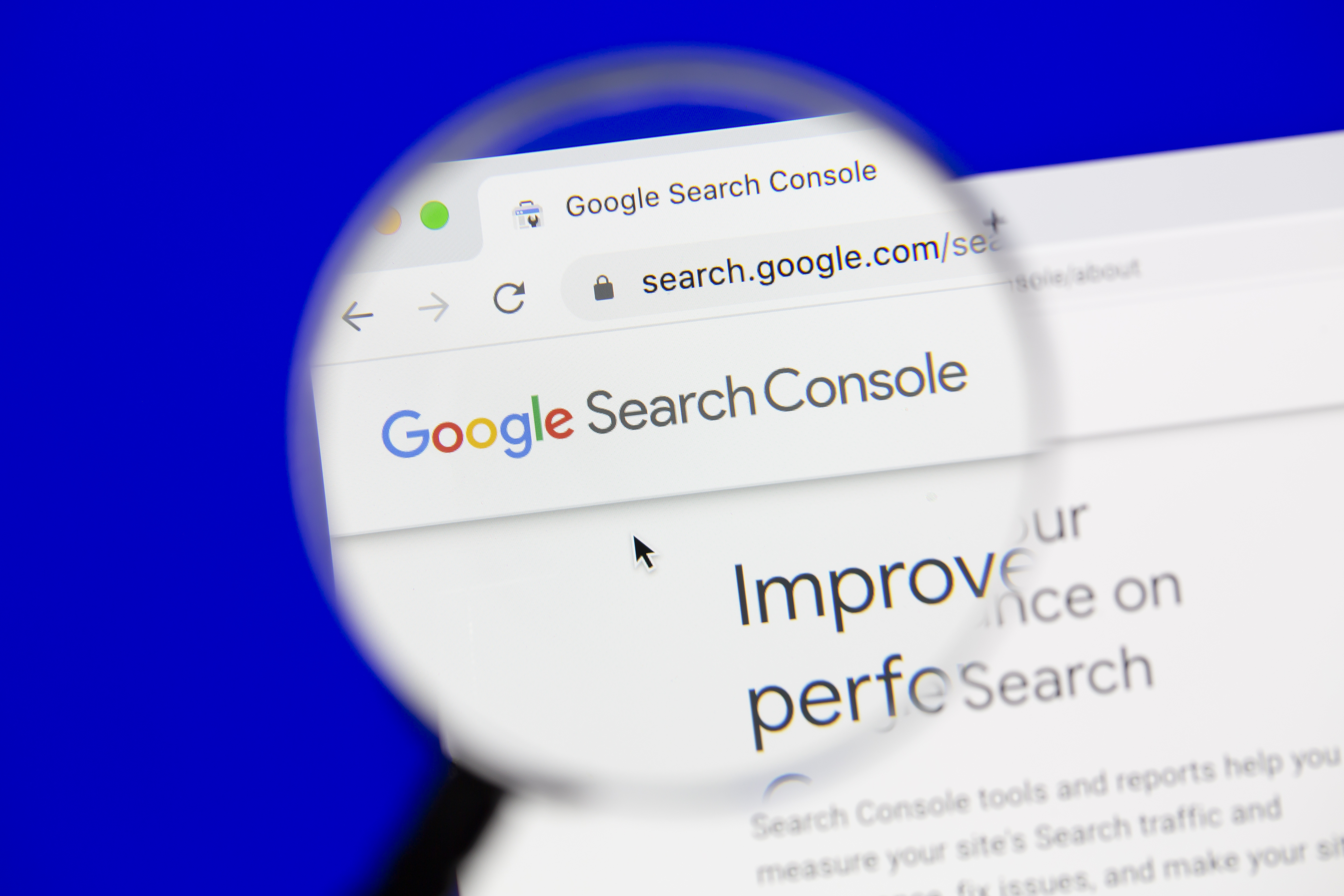
SEO Overview
Want to rank # 1 on all search engines (I.e., Google, Bing, etc...)?
Truth is, it's not easy. There are already millions, if not billions, of other websites, that already exists, and rank for certain keywords. To understand the difficultly of ranking, one must know how search engine’s work, and how websites are ranked.
Good news, below we will give you an introduction to SEO and we will simplify the process, and provide with all the information, techniques, to ranking # 1 on any search engine. We will also uncover and bust common SEO myths, and provide you with the ultimate, all in one SEO guide.
Before we begin, it's important to understand what SEO is, and highlight a few benefits of SEO, organic search engine ranking and why it's essential for every business.
What is SEO?
SEO, stands for Search Engine Optimization, is the process and practice of increasing traffic to your website through organic search engine results.
By ranking on the first page on major search engines results, you will greatly increase your website search traffic and exposure leading to more sales, and revenue. As more people are finding local business online, SEO is now one of the most effective tools utilized, to grow your business.
2 WAYS TO RANK #1 ON GOOGLE (Short Term, Long Term)
-
(Short Term) Google Ads, PPC – Google ads allows you to target any keyword, and rank #1 at a certain cost.
-
(Long Term) SEO – Search Engine Optimization – Ranking your website organically
Paid Ads vs Organic Results
The biggest advantage of running search engine ads (I.e., Google Ads, Bing Ads, etc...) is to increase your website traffic by having your website rank higher for certain keywords. The downside is it can get very expensive, and it is not sustainable (if you stopped your Google Ads, you lose all your traffic). On the other hand, ranking organically (SEO), is a long-term continuous process that allows your website to rank on the first page on all major search engines, capturing traffic, 24/7 without the need to spend money on ads.
It is important to note that both paid ads, and ranking organically should be done consecutively and not one over the other. Neither SEO, or Paid Ads are a replacement for each other. They are merely tools and techniques that once employed, can lead to major increase in your brand awareness and outreach, leading to increase sales and profits.
for this guide, we will focus on ranking organically, without the use of any ads. Before we get started, we will give you 5 reasons (benefits), to ranking on search engines, organically.
5 BENEFITS OF RANKING ORGANICALLY (SEO)
-
You don’t need to pay for search engine ads.
-
73.33% of searches result in a click on an organic result, served on the first page.
-
Increase sales, and outreach
-
Drive Traffic 24/7
-
By simply not showing up and ranking on the first page to consumers when they try to search, for your services, your website is a waste of money.
So far, we have covered what SEO is, we provided you with 2 different ways to rank 1, and we provided some of the benefits of ranking organically. Before going any deeper on how to rank your website, we must have a solid understand, on how search engines work, and what they look for, to rank your website.
How Google Search Engine Work
Google, example.
Main function of Search Engines
The major function of search engines, is to return the best content, that serves the user’s intent. By analyzing google search engine results, we are able to find exactly what Google serves, for any searched keywords.
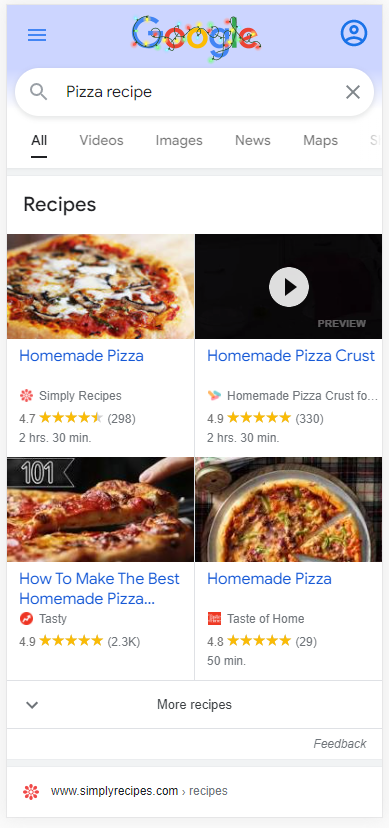
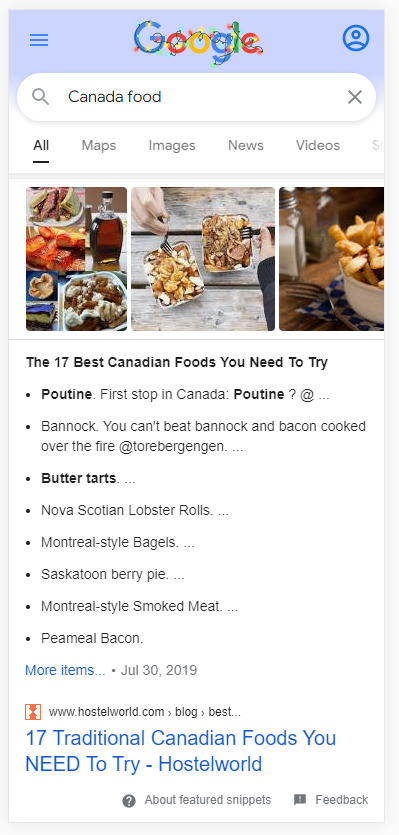
For example, if a user search for “pizza recipe”, then the main function of the search engine, is to return the BEST content, that provides the user with a pizza recipe. As seen in the images, the top-ranking results for the keyword “pizza recipe” are websites that provide pizza recipes for the user.
Similarly, searching for “Canada Food”, we can see that all top-ranking results are blogs. Thus, the search engine has decided that blogs, containing keywords “Canada Food”, are the best results to serve the user search.
By analyzing search results for every specific keyword that we want to target, we are able to see exactly, what the search engine expects. If our goal is to rank for “Canada Food”, then your website must serve the result in a blog format. By analyzing the top results, we are able to see exactly, what the search engine wants and therefore, can create and structure our content, accordingly.
Note that, by simply searching for your keyword, you are able to see exactly what each website did, to rank on the first result. Whether they have videos, images, or even the website content length (number of words), it is important to analyze all the top results for patterns. If all the top-ranking websites, contain, for example 1500 keywords, then we know that our content, will need to be around 1500.
How to rank number 1?
To rank number 1 for a given keyword, your website needs to serve the user, with the best result. If your targeted keyword is a common keyword, then it is most likely that other results, already rank for that keyword. Therefore, your website, needs to “outperform” all the other existing websites. There are lots of factors affecting ranking, but in a nutshell, if your website does not serve the user intent, nor it outperforms all the already existing websites and content, then your website will simply, not rank.
If your dedicated enough to ranking your website, then we will provide you with all the information, techniques, and tips required to ranking your website organically, regardless of the keyword's difficulty. By the end this guide, you will be able to
-
Understand how search engine works
-
Find out exactly what you need to do, to rank #1
-
Know how to rank #1
Before we go any deeper, it is essential, to know what keywords are, how to identify “good” and “bad” keywords and how to determine keywords ranking difficulty.
Keywords Research & Targeting
Whether you want to grow your business, rank for certain keywords, dominate your market or increase your outreach, your targeted keywords are one of the deciding factors, to your online success.
For example, consider a company offering local landscaping services. If they rank for keywords like, “apples” and “oranges” then it would be clear, that the traffic driven from such keywords, is a waste of impression, clicks and the driven traffic, is useless. On the other hand, if they rank for all the keywords, that drive relevant traffic, they would receive relevant traffic.
Define Keywords: in terms of SEO, keywords are the words, people use in search engine such as Google. For example, if you search for “pizza near me”, that search contains 3 keywords “pizza”, “near”, “me”.
How to determine a “good” and “bad” keyword?
In a nutshell, a “good” keyword to target, is a keyword that relates to your business and can capture traffic. If the keywords you are targeting, have no traffic, then you will not see any benefit from targeting low traffic keywords. Note, the more traffic a keyword has, the more difficult it becomes to rank for that keyword.
There are lots of resources, we can use to determine how much, estimated searches, a keyword can get. Some of those tools are: Google Trends and Google Ads. Google Trends allows you to analyze the popularity of top searched keywords in Google Search, across various regions and languages.
For example, assume we want to know if the keywords “pizza” and “custom made pizza” have interest (searches). By using Google trends, we are able to quickly determine that “pizza”, is a popular keyword while “custom made pizza”, has 0 searches.
The major function of search engines, is to return the best content, that serves the user’s intent. By analyzing google search engine results, we are able to find exactly what Google serves, for any searched keywords.
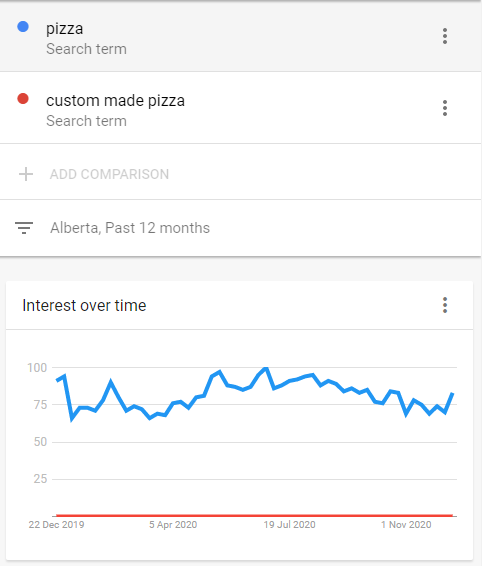
Another way to find keywords, is to use Google’s Autosuggestions. Assume I want to find the most searched keywords, relating to “pizza”. By typing “pizza” in the Google Search Engine, notice how we get a list of suggestions below our keywords. Those suggestions, give you the most searched keywords relating to your keyword “pizza”.
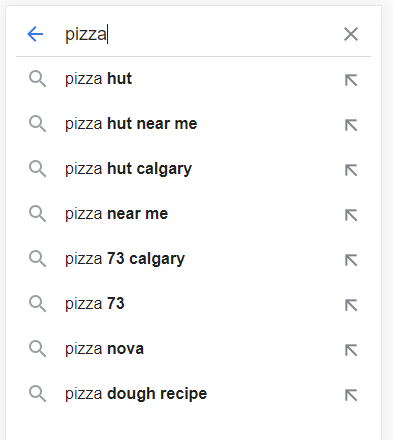
Keywords Difficultly
It is apparent, that the more popular a keyword is, the more traffic it has, and the more competition. Note that the traffic associated with each keyword, is not always a measure to determine it’s a good keyword to target. Sometimes, targeting and ranking for many low traffic keywords can easily add up to drive more traffic, than trying and failing for a big keyword.
This does not mean you should not target popular and difficult keywords, but it should also not be your only primary target. All websites, should target as many keywords as possible, to deliver, the most relevant traffic, to your website. If your primary keyword is “pizza”, then you need to also target, as many keywords that revolve around “pizza” as possible. For example, “pizza cost”, “pizza near me”, “pizza Calgary”, etc. …
Geo Targeting.
Not all traffic is relevant. If you are offering landscaping services in your local city, then receiving traffic from areas outside your service area is irrelevant, and would not help you in any way.
Geo Targeting, is the process of targeting specific cities, areas or communities. The major benefits of geo targeting are getting relevant traffic, and makes keywords targeting easier. For example, “Calgary pizza” would be easier to rank for, than the keyword “pizza”. This is called Local SEO and we will cover it in-depth below.
The GOOGLE Ranking Formula
What Google Loves.
Before deciding on optimizing your website or creating new content, it is essential to analyze the search results Google served, for your targeted keywords. If Google, returns blogs, for your targeted keyword, then your webpage, should be in a blog format. Additionally, if all the top-ranking results have 2500 average words count, then your webpage, should not have 300 words.
There are many factors that Google use, to rank your website. Below, we list the top 8 Google Ranking Factors for late 2020.
-
SSL Certificate (HTTPS secured website)
HTTPS (Hypertext Transfer Protocol Secure) is an internet protocol that protects the integrity and confidentially of data between the user's computer and your website. It is required by major search engines such as google. By installing an SSL certificate & renewing it before expiry, it allows your website to be accessible via https:// which provides 3 layers of protection: encryption, data integrity and authentication.
-
Mobile Friendly Website
Starting July 1 2019, Google adopted mobile-first indexing method. This means that by default, Google uses the mobile version of your content, for indexing (ranking). In 2020, it is essential for your SEO, to have a responsive website (works on mobile).
-
Webpage Content Quality
Your webpage content quality, is a major SEO factor, when it comes to ranking on Google. Your website pages must be well-written, highly valuable and engaging. If you plan on ranking # 1, your content, must richer and more valuable, than all the current existing content. The main function, of any search engine, is to serve the best results, for its users searches.
-
Webpage Content Length
Although there is no correct number to how many words each webpage should be, research shows that long content has a greater probability of earning quality backlinks. It should not be your intent to create content based on words count, but if you are targeting a keyword, where most top-ranking results are between 1500-3000 words, then we know we need to serve our content, within, around, more or a little less than what's already served.
-
Page Speed
Google indicated that your website speed, is one of the signals used by its algorithm to rank your webpages. In addition, a slow page speed means that search engines can crawl fewer pages using their allocated crawl budget, and this could negatively affect your indexation.
Page speed is also important to user experience. Websites, with a longer load time tend to have higher bounce rates and lower than average session time (time on page).
-
Social Signals
Social signals, are interaction metrics on social platforms such as Facebook, Twitter, LinkedIn, etc. For example, likes, dislikes, shares, votes, pins, views, reviews, etc.
-
Backlinks
Backlinks, are essentially, the most important, and valuable for SEO because they represent a “vote of confidence” from one website, to another. Backlinks to your website provide a signal to search engines that others vouch for your content, which would help, rank your webpage higher
To rank#1, it is important to analyze how many backlinks each website has, on the top 10 results in Google. To rank higher, your website should have a stronger backlink profile.
-
User Experience
The user experience, is the ultimate deciding factor in SEO. For example, if your website has a very high bounce rate, and users are spending little to no time, then your content will simply not rank.
Whether you want to grow your business, rank for certain keywords, dominate your market or increase your outreach, your targeted keywords are one of the deciding factors, to your online success.
For example, consider a company offering local landscaping services. If they rank for keywords like, “apples” and “oranges” then it would be clear, that the traffic driven from such keywords, is a waste of impression, clicks and the driven traffic, is useless. On the other hand, if they rank for all the keywords, that drive relevant traffic, they would receive relevant traffic.
Define Keywords: in terms of SEO, keywords are the words, people use in search engine such as Google. For example, if you search for “pizza near me”, that search contains 3 keywords “pizza”, “near”, “me”.
How to determine a “good” and “bad” keyword?
In a nutshell, a “good” keyword to target, is a keyword that relates to your business and can capture traffic. If the keywords you are targeting, have no traffic, then you will not see any benefit from targeting low traffic keywords. Note, the more traffic a keyword has, the more difficult it becomes to rank for that keyword.
There are lots of resources, we can use to determine how much, estimated searches, a keyword can get. Some of those tools are: Google Trends and Google Ads. Google Trends allows you to analyze the popularity of top searched keywords in Google Search, across various regions and languages.
For example, assume we want to know if the keywords “pizza” and “custom made pizza” have interest (searches). By using Google trends, we are able to quickly determine that “pizza”, is a popular keyword while “custom made pizza”, has 0 searches.
The major function of search engines, is to return the best content, that serves the user’s intent. By analyzing google search engine results, we are able to find exactly what Google serves, for any searched keywords.

Another way to find keywords, is to use Google’s Autosuggestions. Assume I want to find the most searched keywords, relating to “pizza”. By typing “pizza” in the Google Search Engine, notice how we get a list of suggestions below our keywords. Those suggestions, give you the most searched keywords relating to your keyword “pizza”.

Keywords Difficultly
It is apparent, that the more popular a keyword is, the more traffic it has, and the more competition. Note that the traffic associated with each keyword, is not always a measure to determine it’s a good keyword to target. Sometimes, targeting and ranking for many low traffic keywords can easily add up to drive more traffic, than trying and failing for a big keyword.
This does not mean you should not target popular and difficult keywords, but it should also not be your only primary target. All websites, should target as many keywords as possible, to deliver, the most relevant traffic, to your website. If your primary keyword is “pizza”, then you need to also target, as many keywords that revolve around “pizza” as possible. For example, “pizza cost”, “pizza near me”, “pizza Calgary”, etc. …
Geo Targeting.
Not all traffic is relevant. If you are offering landscaping services in your local city, then receiving traffic from areas outside your service area is irrelevant, and would not help you in any way.
Geo Targeting, is the process of targeting specific cities, areas or communities. The major benefits of geo targeting are getting relevant traffic, and makes keywords targeting easier. For example, “Calgary pizza” would be easier to rank for, than the keyword “pizza”. This is called Local SEO and we will cover it in-depth below.
SEO Guide 2020
SEO, can be divided into 3 parts: on page SEO, off page SEO and local SEO.
On Page SEO
On page SEO, is the practice of optimizing your website pages in order to rank higher. On page SEO optimizations, are done onto your website. For example, improving your website load speeds and performance.
Below, we provide you an on-page SEO checklist:
-
Create a Sitemap.
-
Optimize Your HTML. I.e., all image tags should have ALT, Every Page Needs a Unique Title etc. ...
-
Check and Fix all broken links.
-
Create and link all your business social media to and from your website.
-
Add Social Signals
-
Site should be Mobile Friendly.
-
Site should have favicon,
-
Site should have About, Contact, Privacy Policy, Terms of Service Pages and 404 Page. (Landing Pages/Business Profile Sites)
-
Server should be close to your targeted area.
-
Site should load fast. (Optimal speed less than 400ms).
-
Site should work on all browsers (I.E, Edge, Firefox, Chrome, Opera, etc.).
-
URLs should be short and descriptive
-
Make it easy to share your content (I.e., Facebook, twitter share buttons etc. …).
-
Utilize Lighthouse (Inside Google Chrome developer's tool), test your website. And fix all issues.
Off Page SEO
Off page SEO, are actions taken outside your website scope. For example, obtaining a backlink, is off page SEO.
Below, we provide you an off-page SEO checklist:
-
Set Up Google Search Console.
-
Set up Bing Webmaster (if you set google, you can import your website).
-
Create a sitemap. Submit to Google Search Console.
-
Create and link all your business social media to and from your website.
-
Obtain high quality backlinks from reputable sites.
Local SEO
Local SEO revolves around any business with a physical location or a targeted location. For example, a landscaping business, should target local consumers within their city, location or service area. Restaurants, Laundromats, doctors, law offices, grocery stores and many other businesses use Local SEO.
One of the biggest benefits of Local SEO is to drive relevant traffic within your service area. Instead of targeting “landscaping”, we can incorporate the service area: “Calgary landscaping”. This makes ranking a bit easier, and drives relevant traffic to your webpage.
When a user searches for a service or a place, for example “Calgary pizza”, Google ranks the closest pizza stores, to the searcher, first. This means, Google, makes it easier, for local business to rank higher, when consumers are closer to them.
Identifying Good/Bad Backlinks
Not all backlinks are equal. There are low quality backlinks, and high-quality backlinks. Your website backlinks count and quality dictates whether or not your website will rank on Google. Note that, the quality of backlinks, is much more important than the quantity. Infact, having low quality backlinks can have negative consequences, on your website ranking. And in some cases, can get your website backlisted by Google.
Buying backlinks is prohibited. You should NEVER buy backlinks from any vendor. There are lots of vendors that sell unlimited lists of backlinks. The problem with those backlinks is that they have been used, and abused, by many other websites. Google can easily detect these types of backlinks, and in most cases, will remove your results from Google (you lose all your rankings).